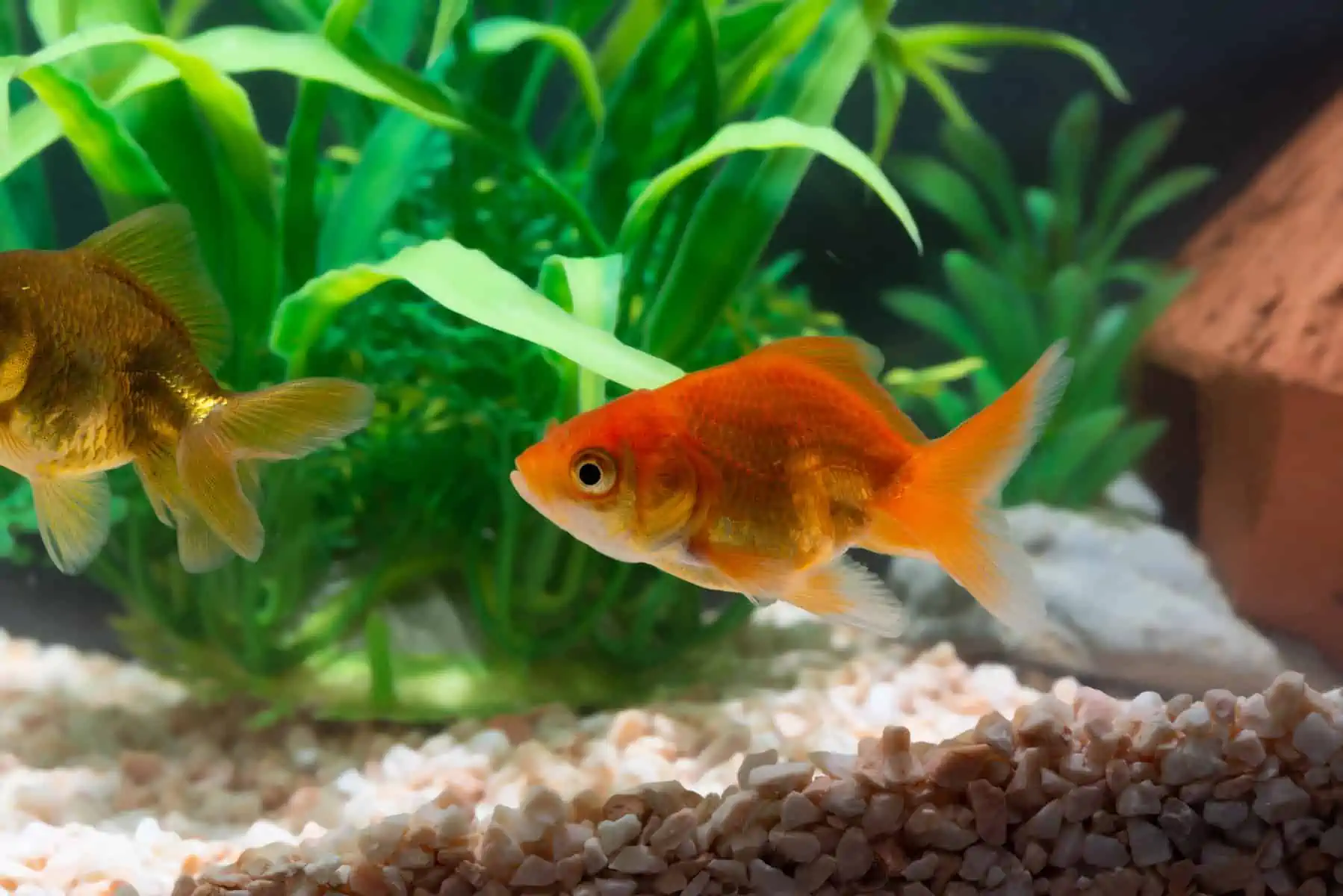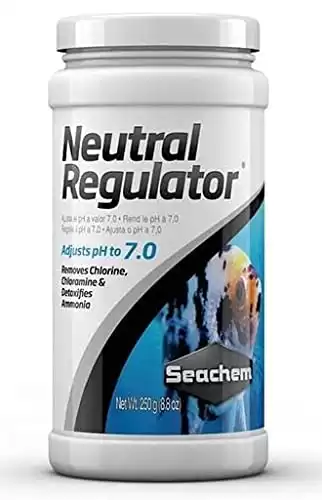So how long can a goldfish live? The answer isn’t as simple as you might think. It depends on several factors, from the type of goldfish to the quality of water they’re living in.
Single-tail goldfish that are kept in good tank conditions normally live for 10 to 15 years. While fancy goldfish have shorter lifespans, common goldfish living in ponds often exceed 20 years of age.
Here I’ll be sharing some interesting facts about goldfish age, as well as offering some top tips on how to help your goldfish live a long and healthy life!
Key Takeaways
- When given proper care, single-tail goldfish will usually exceed 10 years of age. Owing to physical mutations, fancy goldfish are shorter-lived.
- Goldfish lifespan is proportional to their genetics, environment, and quality of care.
- You can help your goldfish live a long and healthy life by offering a large tank, an excellent diet, and water quality. Single-tail goldfish will often live longest in garden ponds.
What Is the Life Expectancy of the Goldfish Species?
The lifespan of goldfish is 10 to 15 years on average. However, some goldfish have been known to live for 20 years or more. Slim-bodied goldfish living in outdoor ponds have even lived for more than 40 years!
In contrast, fancy goldfish have a shorter lifespan of only 7-12 years. This is because they have been inbred to display certain deformities that make them much less robust than single-tail goldfish.
Another key factor in how long goldfish live is the conditions of their environment. Poor water quality in particular is a leading cause of premature death.
Here’s a table that shows the average lifespan of goldfish in various living conditions:
| Conditions | Expected lifespan |
|---|---|
| Goldfish bowl | Less than 2 months |
| Small tank with poor care | 2 to 6 months |
| Small goldfish tanks with good care | 6 months to 2 years |
| Reasonable size tank with poor care | 6 months to 2 years |
| Reasonable size tank with good care | 2 to 5 years |
| A large tank with poor care | 2 to 5 years |
| A large tank with good care | 4 to 8 years |
| A large tank with excellent care | 6 to 10 years |
| Large tank, excellent care, and good genes | 10 years + |
What Is the Lifespan of the Different Varieties of Goldfish?
Not all goldfish are created equal. In addition to the different shapes and sizes of goldfish, there are several different varieties. And each variety has its own lifespan.
Here’s a quick overview of some of the types of goldfish and how long they live on average:
| Goldfish Name | Goldfish Type | Average Lifespan (Tank) | Average Lifespan (Pond) |
|---|---|---|---|
| Common Goldfish | Slim-bodied | 12 – 20 years | 20 years or more |
| Comet Goldfish | Slim-bodied | 10 – 12 years | 15 – 20 years |
| Oranda Goldfish | Fancy Goldfish | 10 – 12 years | 10 – 15 years |
| Fantail Goldfish | Fancy Goldfish | 10 – 12 years | 10 – 15 years |
| Shubunkin Goldfish | Fancy Goldfish | 12 years | 14 or 15 years |
How To Prolong My Goldfish’s Life?
Maintain Good Water Quality
How long would you expect yourself to live in a polluted environment? Well, the same goes for goldfish.
To maintain good water quality, you should stick to a regular maintenance schedule. This means changing 25-50% of the water weekly and vacuuming the gravel to remove any waste buildup.
Also, you should test the water regularly for ammonia, nitrites, and nitrates. If these levels are too high, they can cause fish poisoning.
Provide Them With a Healthy Diet
Just like humans, goldfish need a well-rounded diet to stay healthy and live long lives. In their natural habitat, goldfish eat a variety of small insects, crustaceans, and plants.
In captivity, you should provide them with a diet replicating their natural diet as much as possible. Some of the best foods for goldfish include:
- Pellets and fish flakes
- Live food (brine shrimp, daphnia, bloodworms, earthworms, and mosquito larvae)
- Vegetables (spinach, peas, zucchini, broccoli)
- Aquatic plants (duckweed and elodea)
When it comes to feeding frequency, you should feed them 2-3 times a day. But only give them as much food as they can eat in 2 minutes. Any uneaten food will sink to the bottom of the tank and pollute the water.
Additionally, you should never feed them more than the stated amount on the food packaging. Overfeeding is one of the most common mistakes goldfish owners make, and it can quickly lead to health problems such as swim bladder disease.
Maintain Proper pH Level & Water Temperature
There is nothing more stressful to goldfish than sudden changes in pH level and water temperature. Even a slight change can cause them to go into shock, which can lead to death.
Ideally, you should maintain a pH level between 7-8, and the water temperature should be between 65-72 °F for fancy goldfish and 60° to 72°F for common goldfish.
To ensure the pH level doesn’t fluctuate, you should test it regularly and only make small adjustments when necessary. For example, if the pH level is too low, you can use a pH-up product to raise it slowly, such as the Seachem Neutral Regulator.
- Adjusts pH to neutral
- Removes Chlorine, Chloramine
- Detoxifies ammonia
Provide Them With the Proper Tank Size
Film, TV, and children’s books often depict goldfish in small bowls or fishbowls. But the truth is, this is one of the worst things you can do for your goldfish.
Goldfish need a lot of space to swim and thrive. A single goldfish needs at least 30 gallons. But if you want to keep more than one fish, you need an additional 15 gallons for each fish.
So, if you want to keep a pair of goldfish, you need at least a 45-gallon tank. For three fish, you need a 60-gallon tank, and so on.
Otherwise, your goldfish growth will be stunted, their immune system will be weakened, and they will be more susceptible to diseases. Not to mention, they will have a shorter lifespan.
Give Them Additional Oxygen and Aeration
One of the best ways to provide your goldfish with extra oxygen is to use an air pump and stone. The air pump will push air through the stone and into the water, which will help oxygenate it.
Also, you can use a bubbler, a device that produces tiny bubbles. These bubbles will help oxygenate the water and provide your goldfish with something to play with.
Plus, you can add aquatic plants to your tank. Aside from oxygenating the water, they will also help remove toxins and improve water quality.
Place Them in an Outdoor Pond
Goldfish are native to freshwater streams and ponds in the wild. Seasonal variations, adequate natural light, and naturally available sources of many foods (e.g., plants, insects, larvae) make an outside pond the finest environment for a single-tail goldfish to live longer.
However, don’t put fancy goldfish like Pearlscales in a pond since they are unlikely to survive.
To create a suitable pond for your goldfish, you should adjust their diet and supplement it with aquatic plants. Also, you should regularly test the pH level to ensure they are within the ideal range.
Keep Them Away From the Predators

Goldfish are still susceptible to predators even when kept in backyards. Adult goldfish are most at risk from herons, cats, birds, and raccoons. Also, frogs and salamanders may pose a hazard.
Although high, tight fences can sometimes help keep animals out, it is not always effective. The best way to protect your pet goldfish is by using leaf nets or another type of coverage that fits snugly.
Another way to scare predators away is motion-sensitive sprinkler systems. Further, you can build man-made fish shelters where your fish can go and hide when they feel threatened.
FAQs
What Is the Impact of Water Volume on a Goldfish’s Lifespan?
Water volume has a direct impact on how long goldfish live. A larger water volume provides more space for the fish to swim around and helps dilute toxins and keep the water clean.
Thus, goldfish in large tanks or ponds tend to live longer than those in small tanks.
What Is the Lifespan of a Goldfish Living in a Bag?
If you have a goldfish, do not keep it in an air-filled plastic bag for more than nine hours. If the bag has holes for the fish to breathe, it can stay safely there for up to two days.
How Long Can Goldfish Survive in a Bowl?
Goldfish should never be kept in goldfish bowls, not even for one day! We explain why in our article on Why Goldfish Bowls Should Be Banned.
What Is the Lifespan of a Goldfish Living in a Pond?
Goldfish kept in ponds tend to live longer than those kept in tanks. In a healthy pond ecosystem, common goldfish regularly live for over 20 years.
What Is the Life Expectancy of a Goldfish Without Food?
According to Cafishvet.com, goldfish can live for up to 5-6 days without food when kept at 65°F. Their survival time, however, decreases very rapidly in warmer temperatures.
How Long Can Goldfish Survive Without Being in Water?
According to Smorescience.com, goldfish can live for 1-3 hours out of water. They’ll suffer considerable stress from the experience, however, which could prove fatal.
Why Do Goldfish Die So Quickly?
There are several reasons why a goldfish may die prematurely. As discussed above, poor water quality and cramped conditions are the leading causes of fish dying young.
How Large Can Goldfish Grow?
Depending on the type, goldfish grown in captivity can reach different lengths. For example, slimmer-bodied goldfish have been known to grow up to 10 inches, while fancier breeds typically only grow to be 6-8 inches long.
In contrast, goldfish living in the wild have been observed growing up to 12-14 inches. A man from the Netherlands owned the largest recorded golden fish, measuring an impressive 18.7 inches in length!
What Are the Goldfish That Live the Longest?
The species of goldfish that live the longest are common goldfish, Shubunkins, and Comets. While these fish require much more tank space than fancy goldfish, they have been known to have lifespans exceeding 10 years.
What Is the Age of the Oldest Goldfish?
A fish named Tish was born in 1956 and passed away at 43 years old, setting the Guinness World Record as the longest-living goldfish.
Is Keeping Fancy Goldfish Cruel?
Because fancy goldfish often suffer health problems and die young, I’d encourage you to question the ethics of keeping them. You can join a lovely discussion of the topic on Reddit, here.
Last Words
Now that you know how long goldfish live, you can take the necessary steps to ensure that your fish has a long and healthy life.
Just remember to give your goldfish plenty of space to swim around, provide a high-quality diet, and keep the water clean and at the right temperature.



